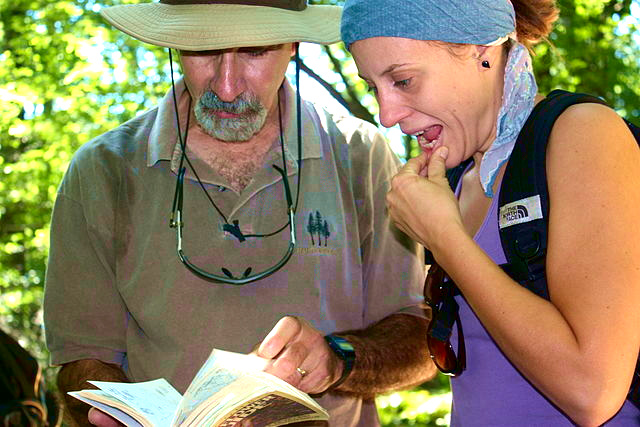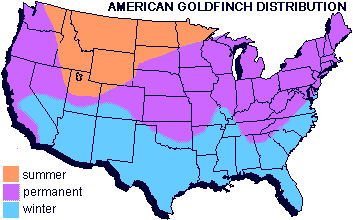 Using a field guide to identify wildflowers in the field; image courtesy of Gary Peeples/USFWS
Using a field guide to identify wildflowers in the field; image courtesy of Gary Peeples/USFWSField guides are special kinds of books, usually books that can fit into a pocket, designed specifically to help us, alone or with others, identify things outdoors, as done a the right.
Mainly field guides deal with plants and animals, but also there are those for identifying footprints, rocks and minerals, clouds, the stars and planets, and many other things. Most field guides are absolutely packed with hundreds of illustrations and one never tires of thumbing through them.
FIELD GUIDES IDENTIFY & TEACH

The field guide identifies your bird as an American Goldfinch, and the distribution map accompanying the illustration, similar to what's shown at the left, indicates its seasonal migration pattern.
But, probably that's just the beginning:
- It may describe the song
- and the preferred habitat (woods, grassland, beach, etc.)
- plumage variations
- and any special quirks of behavior (such as the constant bobbing of the tail, done by Spotted Sandpipers)
DETAILED & LIMITED FIELD GUIDES
Here's something to keep in mind: Most field guides to birds, mammals, reptiles and amphibians, trees, grasses and ferns include all or nearly all species occurring in the geographic region they claim to cover. However, in any pocket-size regional or national field guide to the insects, wildflowers, weeds, or mushrooms, you can bet that all species won't be considered. Those field guides will be limited to just the common species.
 About 11,000 named mushroom species are estimated to occur in North America. Some, if you eat them, are delicious, while others can kill you. When you're identifying a mushroom you want to eat in a pocket-size field guide to North American mushrooms, can you really be sure of your identification... ?
About 11,000 named mushroom species are estimated to occur in North America. Some, if you eat them, are delicious, while others can kill you. When you're identifying a mushroom you want to eat in a pocket-size field guide to North American mushrooms, can you really be sure of your identification... ?That's because over large areas, there are simply too many species of insects, wildflowers, weeds, and mushrooms to fit into a field guide small enough to use in the field. Also, all species of insects, wildflowers, weeds, or mushrooms aren't even known to science! About 900,000 insect species are recognized worldwide, but most authorities agree that more insect species have not been scientifically documented, than have been. (Smithsonian Institution, 2021).
Still, field guides for insects, wildflowers, weeds, and mushrooms, are very useful, but also they teach us how to approach the identification of species in each large group -- how to pay attention to veins in insect wings, for example. They help us learn the various groupings of things, such as how so many wildflowers belong to the big Aster or Composite Family, the Asteraceae, and how to identify that family. If you know special features of that family, then automatically you know special features of many of your local wildflowers.
NARROW FOCUS FIELD GUIDES
Always be on the lookout for field guides limiting themselves to small geographic areas and/or small sections of large groups of organisms. For example, if you have the Northeastern Tiger Beetles field guide limiting itself to the US's New England region and eastern Canada, it'll "only" be considering the 2,600 or so species and subspecies of tiger beetles out of the nearly 30,000 beetle species known in the US. (Tiger beetles are members of the subfamily Cincindelinae of the Ground Beetle family Carabidae, of the Beetle Order Coloptera... )
Therefore: If you happen to live in New England or eastern Canada, are interested in tiger beetles, and you have the Northeastern Tiger Beetles field guide, you have a gold mine, beetly speaking, and a key not only to the world of tiger beetles but also to endless hours of happy naturalizing!